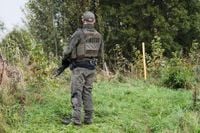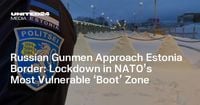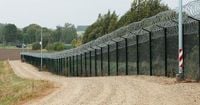In a move that has drawn international attention and underscored growing anxieties on NATO’s eastern flank, Estonia temporarily closed a road passing through a peculiar slice of Russian territory known as the Saatse Boot after border guards observed an unusually large group of armed Russian soldiers near the route. The closure, announced on October 10, 2025, was reported by Estonia’s public broadcaster and later confirmed by multiple Estonian officials, reflecting the country’s heightened vigilance amid a series of recent cross-border incidents involving Russia.
The Saatse Boot, a boot-shaped protrusion of Russian land extending into southeastern Estonia’s verdant countryside, has long been a logistical oddity and a symbol of the region’s tangled history. The one-kilometer stretch of road, which briefly cuts through Russia’s Pskov region before re-entering Estonia, is used daily by local residents and tourists. Under a longstanding agreement, travelers can drive or cycle through this corridor without a visa or border control—provided they do not stop, walk, or deviate from the road while in Russian territory.
But on the evening of October 10, Estonian patrols noticed something out of the ordinary. The Police and Border Guard Board reported “significantly more active movements on the Russian side than usual,” including groups of armed men—estimated by media to number between seven and ten—forming a line across the road. Russian border patrols are a regular sight in the vicinity, but their presence standing directly in the middle of the road used by Estonians was, as ERR noted, highly out of the ordinary.
“We decided to close the road to prevent potential provocations or incidents, as our goal is to ensure the safety of Estonian citizens,” the Police and Border Guard Board said in a statement to ERR. Border patrols were dispatched to both sides of the road to warn drivers and recommend avoiding the area. Access to the Saatse Boot was formally halted on October 11, with the closure expected to last at least until October 14, according to Interior Minister Igor Taro.
Estonian authorities wasted no time in seeking clarification from Moscow regarding the activity. The Russian side, for its part, described the movements as “absolutely routine actions,” according to ERR. Yet for Estonia, the proximity of armed personnel to a civilian route—even for a brief period—was reason enough to take preventative action. The closure was necessary, the border agency stressed, “to ensure the safety of people in Estonia and to prevent possible incidents.”
Interior Minister Igor Taro told the daily newspaper Postimees on October 11 that the Russian soldiers had since left the area and that the situation was calm. “There is no direct threat of war. This has been constantly confirmed by the Estonian Defense Forces. The Saatse Boot incident has not changed the situation,” he said, as quoted by the public broadcaster EER. The road, however, would remain closed at least until Tuesday, October 14, as a precaution.
Estonian Foreign Minister Margus Tsahkna also sought to tamp down speculation about rising tensions. “Reports suggesting that the situation on the Estonian-Russian border is becoming tense are exaggerated,” Tsahkna said in a statement posted to social media on October 12. He acknowledged that Russia was “acting somewhat more assertively and visible than before, but the situation remains under control.” Echoing this, border guard official Künter Pedoski emphasized, “Our goal is to ensure the safety of the Estonian people.”
The episode comes at a sensitive time for Estonia and its NATO allies. Just last month, three Russian fighter jets, reportedly capable of carrying advanced, nuclear-capable missiles, entered Estonian airspace without permission and lingered for 12 minutes—a violation that prompted both Tallinn and Warsaw to invoke NATO’s Article 4, which calls on member nations to consult when territorial integrity or security is threatened. Moscow denied its MiG-31 aircraft breached NATO airspace, insisting the planes were en route to the Russian exclave of Kaliningrad. Only a week before that, some 20 Russian drones crossed into Poland, marking what many observers described as the most serious cross-border incident involving a NATO member since Russia’s full-scale invasion of Ukraine in February 2022.
Other countries on NATO’s eastern frontier have reported similar incursions and drone crashes on their territory, adding to the region’s sense of unease. In response, Estonia has taken steps to bolster its defenses. In June 2025, the country began building new fortifications along its eastern frontier as part of the broader Baltic Defense Line, a regional initiative aimed at strengthening NATO’s northeastern flank. According to ERR, these measures are designed to deter potential aggression and reassure both Estonian citizens and their NATO allies of the country’s preparedness.
The Saatse Boot itself is a historical and legal anomaly. The enclave, which juts into Estonia and interrupts the flow of local traffic, was the subject of a 2005 border treaty that envisioned exchanging the Russian land for two Estonian plots. However, the agreement was never ratified, and Estonia has since ruled out any future land swaps with Russia. Recognizing the persistent risks and complications posed by the arrangement, Estonian authorities have begun constructing a new bypass road. The new route, expected to open fully by 2026, will allow travelers to avoid Russian territory entirely, closing the book on one of Europe’s more peculiar border quirks.
For now, the closure of the Saatse Boot is a reminder of the delicate balance that exists along the borders of NATO and Russia. While officials on both sides have downplayed the risk of escalation, the incident highlights how even routine military movements can spark anxiety and swift action in an era of heightened mistrust. As Foreign Minister Tsahkna put it succinctly, “To be clear: nothing acute is happening on the border.” Still, with memories of recent airspace violations fresh and regional security at the forefront of public consciousness, Estonia’s cautious approach has found broad support at home.
The road remains closed, but the broader story—of vigilance, diplomacy, and the challenges of living next door to an unpredictable neighbor—continues to unfold in Estonia and across NATO’s eastern edge.


